Lasagne al Pesto con Fagiolini e Patate - Pesto Lasagna with Green Beans and Potatoes
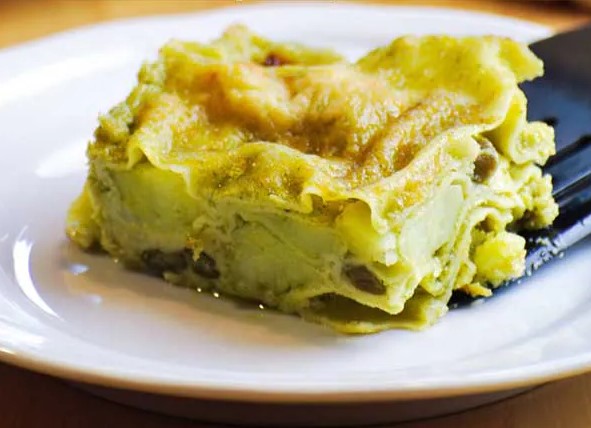
Ingredients for a 25×20 cm (10×8 inch) baking dish:
For Lasagna Noodles
- From 7 to 10 lasagna: you can make fresh homemade lasagna noodles following our step by step recipe: how to make Homemade Pasta
- Or you can buy authentic Italian flat lasagna, oven ready (no cooking or boiling necessary), made with durum wheat (we recommend Tuscanini brand)
- 500 ml (2 cups) of whole milk
- 50 g (1,7 oz = 3 1/2 tablespoons) of unsalted butter
- 50 g (1,7 oz = 4 tablespoons) of all-purpose flour
- fine salt to taste
- 50 g of basil leaves (about 60/65 leaves)
- 1/2 cup of extra virgin olive oil
- 70 g (1/2 cup) of Parmigiano Reggiano
- 30 g (2 tablespoons) of Pecorino Fiore Sardo</a
- 2 peeled garlic cloves
- 15 g (1 tablespoon) of pine nuts
- 4 or 5 grains of coarse salt
- ice
- 200 g (7 oz) of green beans
- 2 medium potatoes
- 200 g (1 cup) of freshly grated Parmigiano cheese
- To make Pesto Lasagna with Green Beans and Potatoes, first prepare the pesto. You can keep it in the refrigerator for up to 3 days.
Wash the basil leaves in cold water. Place them in a large bowl with plenty of ice for 3-4 minutes. This will make your pesto super green! - Now dry the leaves VERY WELL on a kitchen towel. Place them in a food processor with the garlic, pine nuts and grated Parmigiano cheese.
- Coarsely chop the ingredients for a few seconds. Add the salt and the grated Pecorino Fiore Sardo cheese. Mix all the ingredients together for about 1 minute.
Add the extra virgin olive oil. Blend for about 5 minutes until the pesto is ready, green and creamy!
TIP: pesto should not get hot, so use the food processor at the lowest speed and in pulses, that is, blend for a few seconds, stop and start again. - Melt the butter in a saucepan over low heat and add the flour – using a sieve – whisking quickly.
Cook for 30 seconds/1 minute, stirring, so that the flour becomes more flavorful and absorbs the fat from the butter.
The mixture of butter and flour is called roux and should turn a nice golden color.
Meanwhile, heat the milk without bringing it to a boil. - Turn off the heat. Slowly pour the hot milk over the roux, stirring well with a whisk to prevent lumps from forming.
When the milk is completely poured over the roux sauce, return the saucepan to low heat.
Continue stirring until you reach a fairly thick consistency (about 10 to 15 minutes).
The sauce is ready when it sticks to the back of a wooden spoon. Finally, taste and add a pinch of fine salt to taste.
If you used a whisk and stirred at supersonic speed, there should be no lumps in the sauce. If there are lumps, use an immersion blender to whisk the sauce until the lumps dissolve. - Now cook the vegetables. Peel and halve the potatoes. Wash the green beans and cut off the ends.
Place the potatoes in a large pot of lightly salted water. Bring the water to a boil. When it boils, add the green beans and cook for 15 to 20 minutes.
When vegetables are cooked, drain and set aside. - Now prepare the pesto béchamel sauce. In a bowl, add the pesto to the béchamel sauce and mix. Set aside.
- FRESH LASAGNA: If you want to use fresh lasagne sheets, you must first cook them. Cook the lasagne sheets in boiling water for 1 minute. Place the cooked lasagna on clean tea towels, spaced apart.
DRY LASAGNA: If you want to use dry, packaged lasagna instead, you don’t have to do anything.
Now that you have prepared all the ingredients, proceed to make the pesto lasagna with potatoes and green beans.
Spread a little pesto béchamel sauce on a baking dish, then add enough lasagna to cover the bottom of the dish. Top with another layer of pesto béchamel sauce. - Add 2 to 3 tablespoons of Parmigiano cheese. Then add some roughly chopped potatoes and green beans, covering the entire surface.
Cover with another lasagna and start again: pesto sauce and béchamel sauce – parmigiano cheese – green beans and potatoes (repeat).
Continue making layers until all the ingredients are finished, or at least until the baking dish is full. - Top with a sheet of lasagna, a layer of pesto béchamel sauce and plenty of grated Parmigiano cheese.
Cover the pesto lasagna with aluminum foil. Bake in a preheated oven at 180°C (356°F) for 20 minutes. - Remove the aluminum foil and finish cooking in the oven for an additional 10 minutes.
Allow the pesto, potato, and green bean lasagna to cool to room temperature for 10 minutes before serving.
https://www.recipesfromitaly.com/vegetarian-lasagna-with-pesto/
Lasagne alla Zucca - Pumpkin Lasagna
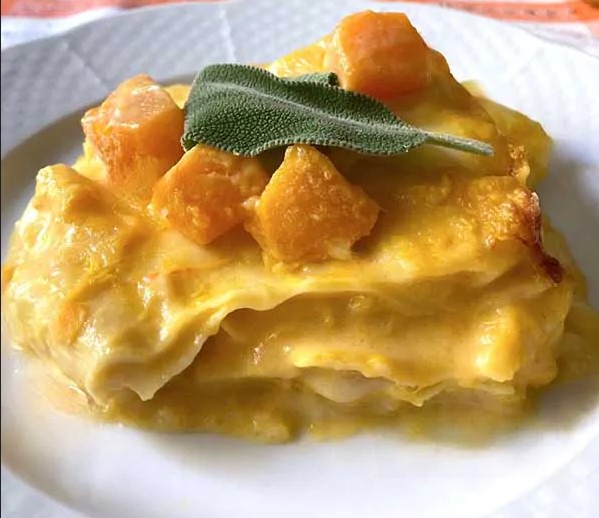
Ingredients for a 13×9 inch lasagna pan:
For Pumpkin filling
- 1 kg (2,2 pounds) of pumpkin pulp. We used Mantua Squash because it’s very common in northern Italy. You can substitute it with Butternut Squash, Buttercup or Kabocha Squash.
- 200 g (2 cups) of grated Parmigiano Reggiano cheese
- 300 g (10,5 oz) of Mozzarella or Buffalo Mozzarella
- 3 tablespoons of extra virgin olive oil
- 2 cloves of garlic
- fine salt
- some sage leaves
- About 12 lasagna: you can make fresh homemade lasagna noodles following our step by step recipe: here you can find out how to make Italian Homemade Pasta
- Or you can buy authentic Italian flat lasagna, oven ready (no cooking or boiling necessary), made with durum wheat (we recommend Tuscanini brand)
- 500 ml (2 cups) of whole milk
- 50 g (half stick) of unsalted butter
- 50 g (4 tablespoons) of all-purpose flour
- 1⁄4 teaspoon of fine salt
- freshly grated nutmeg
- In a saucepan, melt the butter over low heat. Add the flour with the help of a flour sieve: in this way you are sure that there are no lumps. Mix quickly with a whisk, until the mixture is smooth.
The mixture of butter and flour is called roux and it should be a nice golden color. - Meanwhile heat the milk, without bringing to a boil. Pour the milk slowly over the roux, while stirring with a whisk. Season with salt and grated nutmeg.
Put the saucepan back on low heat. Keep mixing constantly, until you have a fairly thick consistency for about 10/15 minutes. The sauce is ready when it sticks to the back of a wooden spoon. Set aside. - Peel the pumpkin on a cutting board and remove the inner seeds. Then cut it into cubes. You will need to get about 1 kg (2,2 pounds) of pulp from it, net of scraps.
- Place the pumpkin in a skillet with the oil, peeled garlic cloves, a few sage leaves and some salt. Let it season over medium heat for about 5 minutes while stirring.
- Then lower the heat and let it cook for about 15-20 minutes. There is no need to add water or broth because the pumpkin will release its own water. The squash will be ready when it is very soft.
When the pumpkin is cooked, remove the garlic and sage leaves. Mash about 2/3 of it with a fork to make a pumpkin puree. Set aside the remaining chopped pumpkin. - While the pumpkin is cooking, cut the mozzarella into cubes and place in a strainer to remove as much liquid as possible.
- When the pumpkin purée has cooled, add it to the béchamel sauce and mix well.
- Place two or three tablespoons of pumpkin béchamel on the bottom of a baking pan or a casserole. Then lay down the first layer of lasagna noodles.
- Cover them with other 2 or 3 pumpkin béchamel, a few cubes of mozzarella cheese and some grated Parmigiano cheese.
- Continue making layers (lasagna noodles + pumpkin béchamel + mozzarella + grated parmigiano) until you finish all ingredients.
Finish the last layer with plenty of grated parmigiano to create a crispy crust while baking. Add on top the cubed cooked pumpkin you set aside and a few sage leaves. - Bake in a preheated oven at 180° C (350° F) for about 30 minutes, until the surface is golden.
Let Pumpkin Lasagna cool for 10-15 minutes before serving. This will firm up the lasagna and make it easier to make portions.
You can replace the two cheeses, mozzarella and Parmigiano, with stronger-flavored cheeses:
PECORINO ROMANO – The sweet flavor of pumpkin goes well with pecorino romano, which can replace all or part of the parmigiano.
SCAMORZA – To still have the tasty stringy effect but with more flavor, you can replace mozzarella with smoked scamorza.
GORGONZOLA – A few pieces of gorgonzola cheese between layers will also make the pumpkin lasagna richer and more flavorful.
What Kind of Pumpkin Should I use to Make Pumpkin Lasagna?
For pumpkin lasagna, there is no ideal type of pumpkin. The only important thing is that the pumpkin is not too watery.
If it is, we recommend extending the cooking time a bit and allowing the liquid to evaporate well.
Or you can add a potato, which will make the pumpkin puree firmer.
Reference:
https://www.recipesfromitaly.com/pumpkin-lasagna/
Lasagne agli spinaci - Spinach lasagna
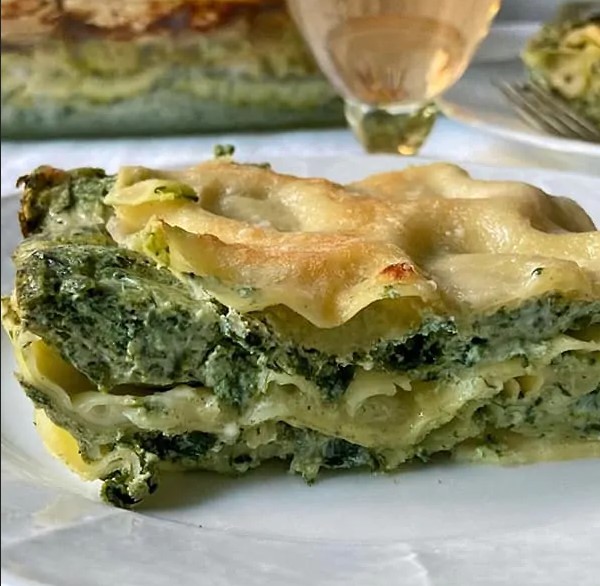
Ingredients for a 13×9 inch lasagna pan:
For Spinach and Ricotta filling
- 500 g (1,1 lb) of fresh spinach
- 500 g (1,1 lb) of ricotta
- 200 g (2 cups) of grated Parmigiano cheese
- freshly grated nutmeg
- fine salt
- freshly grated black pepper
- About 12 lasagna: you can make fresh homemade lasagna noodles following our step by step recipe: here you can find out how to make Italian Homemade Pasta
- Or you can buy authentic Italian flat lasagna, oven ready (no cooking or boiling necessary), made with durum wheat (we recommend Tuscanini brand).
- 500 ml (2 cups) of whole milk
- 50 g (half stick) of unsalted butter
- 50 g (4 tablespoons) of all-purpose flour
- 1⁄4 teaspoon of fine salt
- freshly grated nutmeg
- In a saucepan, melt the butter over low heat. Add the flour with the help of a flour sieve: in this way you are sure that there are no lumps. Mix quickly with a whisk, until the mixture is smooth.
The mixture of butter and flour is called roux and it should be a nice golden color. - Meanwhile heat the milk, without bringing to a boil. Pour the milk slowly over the roux, while stirring with a whisk. Season with salt and grated nutmeg.
Put the saucepan back on low heat. Keep mixing constantly, until you have a fairly thick consistency for about 10/15 minutes. The sauce is ready when it sticks to the back of a wooden spoon. Set aside. - Boil the spinach in a pot with very little salted water for a few minutes, until tender. If you are using frozen spinach, when water start boiling, cook for 5 minutes.
- Drain and let them cool, then squeeze to remove excess water, finally chop with a hand immersion blender.
- In a bowl, combine the chopped spinach with the ricotta, half of the grated Parmigiano, a pinch of fine salt, freshly grated black pepper and nutmeg to taste. Mix all the ingredients until you get a creamy mixture.
Spinach and ricotta filling is ready. Now you have to assemble your spinach lasagna. - Place two or three tablespoons of béchamel on the bottom of a baking pan or a casserole, then lay down the first layer of lasagna noodles and cover them with the spinach and ricotta filling.
- Now cover with some bèchamel and finish with two or three tablespoons of grated Parmigiano.
Keep making the layers (lasagna noodles + spinach and ricotta filling + bèchamel + grated Parmigiano) till you finish all the ingredients.
End the last layer with plenty of Parmigiano cheese to create a crispy crust during cooking. - Bake in a preheated oven at 180° C (350 F) for about 30 minutes, until the surface is golden. Let spinach lasagna cool for 5-10 minutes before serving.
What Can I Substitute for Spinach in Lasagna?
If you don’t like the taste of spinach or want a different flavor, you can substitute spinach in Lasagna with chard, chicory or zucchini.
Spinach Lasagna with Tomato Sauce
The most common variant is the addition of tomato sauce. Make some Tomato Sauce from Fresh Tomatoes or make a marinara sauce with the tomato passata.
You can use the tomato sauce in addition to the bechamel or substitute the bechamel with it, according to your tastes. In the first case you will have a richer and very creamy dish. In the second case you will have a lighter vegetarian lasagna.
Vegetarian Spinach and Ricotta Lasagne without Parmigiano Cheese
If you prefer not to use Parmigiano, you can safely not put it in the recipe. In this case, however, it’s better to use sheep or buffalo ricotta which are tastier than cow ricotta. In addition, to make the gratin on the surface of the spinach lasagna, you can replace the grated Parmigiano with grated salted ricotta or with some breadcrumbs.
Reference:
https://www.recipesfromitaly.com/spinach-lasagna/
Lasagne alla Norma (Lasagne alle melanzane) - Eggplant Lasagna
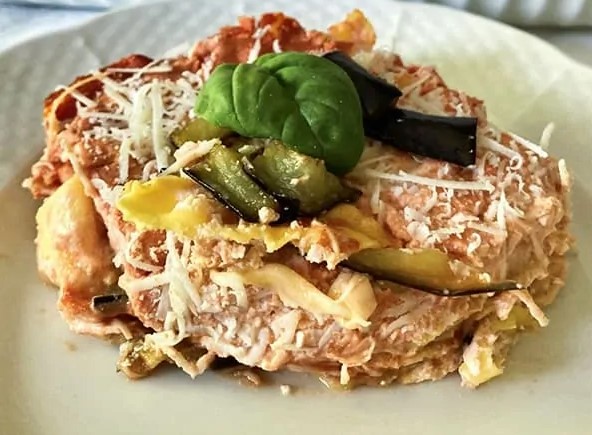
Ingredients for a 13×9 inch lasagna pan:
For the Tomato Sauce
- 1 liter of tomato passata that you can make with our fantastic recipe or buy it already made, ready to use. We reccomend Mutti Tomato Puree (Passata)
- 2 cloves of garlic
- 3 basil leaves
- fine salt to taste
- 300 g (10,5 oz) of fresh Ricotta cheese
- 200 g (7 oz) of grated Ricotta Salata cheese
- 2 medium eggplants
- 1 liter of extra virgin olive oil for frying
- About 10 lasagna: you can make fresh homemade pasta/lasagna noodles following our step by step recipe
- Or you can buy authentic Italian flat lasagna, oven ready (no cooking or boiling necessary), made with durum wheat flour.
- The first thing to do is to make a light tomato sauce. So in a sauce pan pour the tomato passata, add two cloves of garlic, 2/3 basil leaves and a pinch of fine salt to taste.
Cook over low heat for 10 minutes. The tomato sauce have to be quite runny. So if you see that it’s too thick add some water. That’s necessary to bake lasagna noodles. When ready, turn off the heat and set aside. It’s better not to add oil to the tomato sauce in order not to make the Lasagna too greasy. - After washing and drying the eggplants, slice them lengthwise. Make some slices about 1 cm (half an inch) thick. Then cut the ends of the eggplant into cubes (the first and last slice).
- Now fry the eggplant in plenty of extra virgin olive oil, both the slices and the cubes. Fry them to a temperature of 170° C (340 F).
Do not exceed the recommended temperature: check with a kitchen thermometer. Drain with a skimmer and place them on kitchen paper to absorb the excess oil. Set aside.
DO NOT salt the fried eggplants. During the preparation of the eggplant lasagna you will need to add the salted ricotta which is already very salty. - Now place the fresh ricotta in a bowl. Add two or three tablespoons of tomato sauce and mix everything until you get a reddish, homogeneous and thick cream. Set aside.
- Take a 13×9 inch lasagna pan and spread a little ricotta cream on the bottom. Then place the first layer of lasagna. Cover the lasagna with a little ricotta cream. Then add a layer of fried eggplant slices.
- Add 3 or 4 tablespoons of tomato sauce and a little grated salted ricotta. This cheese is very tasty so do not overdo it with the quantity between one layer and another.
- Keep going with the layers until you run out of ingredients, taking care to finish the last layer with only the ricotta cream on top. Bake in a preheated oven at 200°C (390 F) for 20 minutes.
- When cooked, take your eggplant lasagna out of the oven and add the diced fried eggplant and more grated salted ricotta. Decorated with a few basil leaves and let it rest for 10 minutes before serving.
Don’t put too much ricotta cream between one layer and another and on the top of the last layer.
Too much ricotta and tomato sauce cream makes Eggplant Lasagna too mushy and overly covers the texture and flavor of the fried eggplants.
Don’t use to much oil and salt. Eggplants fried in extra virgin olive oil give the dish the necessary seasoning and a great flavor.
If we add oil to the tomato sauce too, the dish would be too heavy and greasy.
Use salt with moderation because salted ricotta is really very tasty and salty. With the addition of too much salt to the tomato sauce or to the fried eggplant you risk ruining the result.
Eggplant Lasagna with Grilled Eggplant
If you want to make a lighter and less caloric dish, maybe better for the summer season, don’t fry the eggplants but grill them.
So cut the eggplants into slices about 1 cm (half an inch) thick. Heat a non-stick grill pan and grill the eggplant slices on one side and then on the other.
In this case you can add two tablespoons of extra virgin olive oil to the tomato sauce.
For an even fresher and particular taste, you can replace the basil leaves with mint leaves.
Reference:
https://www.recipesfromitaly.com/eggplant-lasagna-recipe/
Neapolitan Lasagna (Carnival Lasagna) (Classic Lasagna)
Neapolitan Lasagna recipe was born during the Kingdom of the Two Sicilies. Chefs of the Bourbon court used to make very rich and substantial dishes, as a symbol of wealth and well-being.
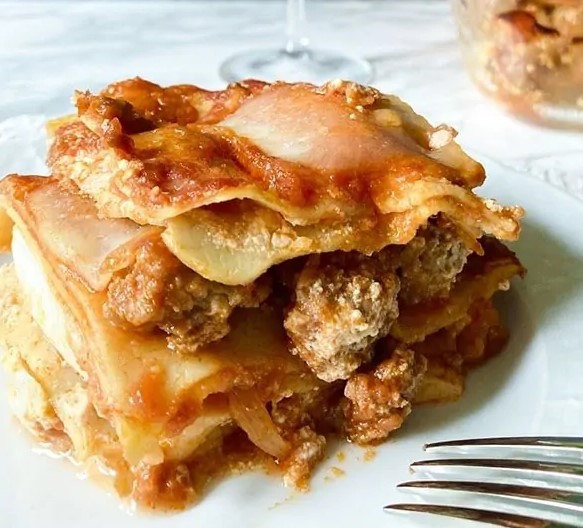
Ingredients for a 13×9 inch lasagna pan:
For the Meat Sauce
- 350 g (12,4 oz) of pork ribs
- 250 g (8,8 oz) of sausage
- 350 g (12,4 oz) of pork neck
- 100 ml of red wine
- 1 medium white onion
- 1,5 liter of tomato passata
- 4 tablespoons of extra virgin olive oil
- fine salt to taste
- 400 g (about 0,90 / 1 lb) of the meat cooked in the sauce, well drained
- 2 tablespoons of chopped parsley
- 2 whole medium eggs
- 100 g (3,5 oz) grated Parmigiano Reggiano cheese
- 100 g (3,5 oz) bread crumbs made with our recipe + more for breading the meatballs
- 1 liter of oil for frying
- 500 g (1,1 lb) of ricotta cheese
- 200 g ( 7 oz ) of grated Parmigiano Reggiano
- 400 g (14 oz) of hard mozzarella cheese
- 4 whole medium eggs
- About 10 lasagna: you can make fresh homemade pasta/lasagna noodles following our step by step recipe
- Or you can buy authentic Italian flat lasagna, oven ready (no cooking or boiling necessary), made with durum wheat (we recommend Tuscanini brand).
Method:
- To make Neapolitan Lasagna start with the preparation of the pork meat sauce. This preparation requires a lot of time. Fortunately, you can prepare it the day before. So Take the pork neck and the ribs and cut them into small pieces. Leave some meat on the bone, it will make the sauce tastier. Then remove the sausage skin. Put the meats and the sausage aside for the moment.
- Now peel the onion and slice it finely. Sautè it in a large pan with the extra virgin olive oil for a few minutes. Then add the sausage and the meats. Cook for 3 or 4 minutes on medium heat, sometime stirring.
- Now pour the red wine, let it evaporate and then add the tomato passata. Add salt to taste, stir and cover with a lid.
- Let simmer over low heat for at least two hours. The sauce should not be too thick. If it seems to dry out too much during cooking, add a ladle or two of water. The sauce must be a little liquid to facilitate the cooking of the lasagna noodles afterwards. When ready, turn off the heat and let the pork meat sauce cool.
- With a slotted spoon, take about 400 g (about 0,90 / 1 lb) of meat from the sauce, draining it very well from the tomato sauce. Place it in a bowl and add the grated Parmigiano, chopped parsley, 100 g (3,5 oz) of bread crumbs, two whole eggs.
- Transfer the mixture in a food processor and finely mince, until homogeneous. With the mixture make small meatballs, no bigger than a hazelnut and bread them quickly in bread crumbs.
- Fry the meatballs in plenty of oil. With a slotted spoon, remove the meatballs from the oil, drain well the excess oil, then put them on a plate and set aside.
- Boil 4 eggs for 10 minutes. Remove the shells while they are still hot. Let them cool then cut into thin slices. Set aside. Cut the hard mozzarella cheese into thin slices as well and set aside.
- Now place the ricotta in a bowl. Add two or three tablespoons of meat sauce and mix everything until you get a homogeneous reddish-cream.
- Take a lasagna pan measuring about 13×9 inches and spread a little meat sauce on the bottom. Then place the first layer of lasagna noodles.
- Cover the pasta sheets with the ricotta cream. Then place a few slices of hard-boiled egg, some fried meatballs and some slices of mozzarella.
- Finally spread the meat sauce and sprinkle with the grated Parmigiano cheese. Cover with another layer of lasagna sheets.
- Keep going with the layers until you run out of ingredients, taking care to make the final layer with only the sauce, mozzarella and grated Parmigiano.
- Cover the pan with aluminum foil so that the top does not dry out too much. Bake in a preheated oven at 200 ° C (390 F) for about 25 minutes. Then remove the aluminum foil and keep cooking for another 5/10 minutes, depending on whether you like the surface more or less crunchy. Then take out the lasagna and let it rest for 10 minutes before serving. Now enjoy your Neapolitan Lasagna!
https://www.recipesfromitaly.com/neapolitan-lasagna-recipe/
Lasagne di pesce - Fish Lasagna
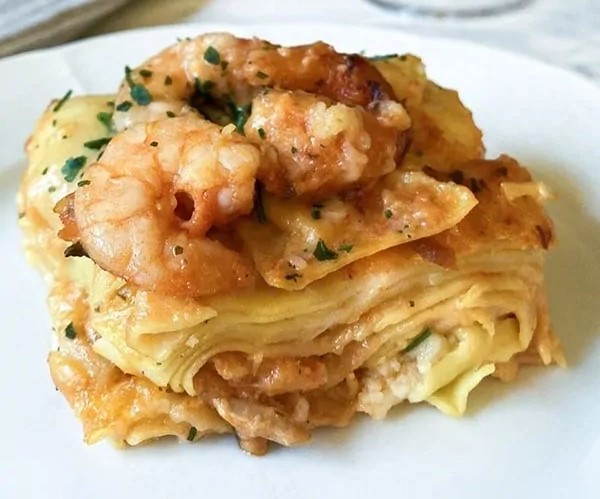
Ingredients for a 13×9 inch lasagna pan:
For Fish Ragu
- 150 g (5 oz) of Squid
- 150 g (5 oz) of Cuttlefish
- 1 whole sea bass of about 400 g (14 oz) or about 150 g (5 oz) of sea bass fillet
- 200 g (7 oz) of Scampi
- 150 g (5 oz) of Shrimps
- 350 g (12,3 oz) of tomato passata
- 2 cloves of garlic
- 1 small onion
- a bunch of chopped fresh parsley
- 60 ml of dry white wine
- 5 tablespoons of extra virgin olive oil
- 1 stalk of celery
- 1 liter of water
- half tablespoon of coarse salt
- 1 medium shallot
- all fish waste (except the entrails) and the claws of crustaceans
- 1 medium carrot
- About 12 lasagna: you can make fresh homemade lasagna noodles following our step by step recipe
- Or you can buy authentic Italian flat lasagna, oven ready (no cooking or boiling necessary), made with durum wheat (we recommend Tuscanini brand)
- 750 ml of fish stock
- 100 g (3,5 oz) of “00” flour
- 5 tablespoons of extra virgin olive oil
- fine salt
- fresh ground black pepper
Method:
- Clean the fish well and prepare a fish stock with the scraps, shells and claws, about a liter of water, a carrot, a piece of celery and a shallot. Boil all together for at least 40 minutes.
This stock will be useful both for cooking the fish sauce and for preparing the bechamel (Step 4 – 5). If you use fish that is already cleaned and therefore have no waste, make with a vegetable broth; obviously the flavor will be less intense. - Make a soffritto with oil, garlic, onion and chopped parsley. Add the mollusks (squid and cuttlefish) cleaned and cut into small pieces and cook for about 5 minutes.
Then blend with the white wine and add the tomato passata. Cook for about 40 minutes adding a little fish stock when necessary. - Now add the shellfish (shrimps and scampi) and the sea bass fillets, always cleaned and cut into pieces.
Keep some shrimp whole. Cook for about 15 minutes, stirring well.
For a successful fish ragu, cooking times are very important. Each type of fish has a different cooking time and you have to add it to the fish ragu based on that. Now the fish ragu is ready, keep it aside. - In a small saucepan, heat the olive oil and add the flour all in one go. Mix with a whisk until the flour is completely soaked in oil.
- Then pour in slowly the hot fish stock, keeping to mix to avoid lumps. Let it cook until you get a smooth and thickened – but still quite fluid – sauce. Finally add a pinch of salt and pepper.
- Now that you have all the main preparations, we can start assembling the layers of your fish lasagna.
If you are using fresh pasta lasagna made with our recipe, DO NOT FORGET to dip them 1 minute in boiling salted water and let cool and dry on kitchen towels before using them for your lasagna recipe.
If you are using the lasagna noodles that we have recommended in the ingredients, you do NOT NEED TO COOK them. They will cook in the oven thanks to the liquids of the fish ragu and bechamel. - Spread on the bottom of a baking dish two tablespoons of bechamel. Then put a lasagna noodle over it, trying to cover the entire bottom of the pan. If one lasagna is not enough for you, use another one, whole or in half, depending on the size of the lasagna.
- Then layer on two tablespoons of fish ragu and two of fish bechamel sauce. With the help of a spoon, cover the entire surface.
- Repeat these steps for about five layers (lasagna – fish ragu – bèchamel ), in any case up to fill your baking dish. To the last layer, add a little more sauce and béchamel to form, during cooking, a crispy crust on the surface of the lasagna.
- Bake in a preheated oven at 180 ° C (350 F) for about 30 minutes. For the first 10 minutes it is better keep the fish lasagna covered with a sheet of aluminum foil so that the sauce and the pieces of fish on the surface do not dry out too much.
Before serving, let the fish lasagna rest for about 10 minutes out of the oven. Serve with a little fresh chopped parsley or ground black pepper according to taste.
https://www.recipesfromitaly.com/fish-lasagna-recipe/
Lasagne alla Bolognese - Authentic Italian Lasagna Bolognese
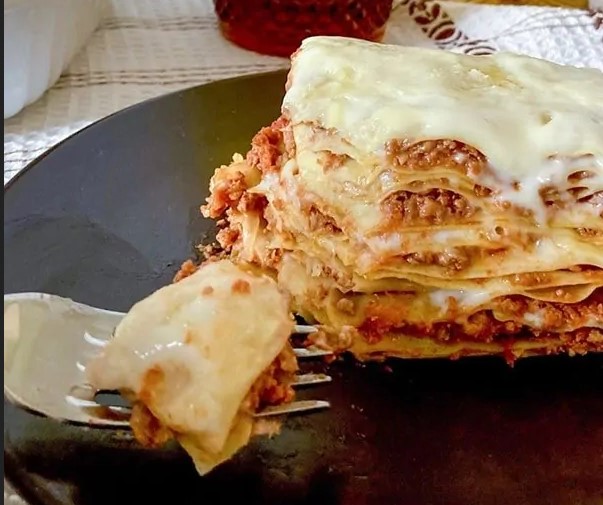
Ingredients for a 13×9 inch lasagna pan:
For Bolognese Sauce (Ragu alla Bolognese)
- 300 g (10 oz) of coarsely ground beef
- 150 g (5 oz) of sliced pancetta (you can replace pancetta with minced pork)
- 300 g (1 1⁄4 cup) of tomato passata or crashed peeled tomato
- 1 small carrot (about 50 g)
- 1 celery stalk (about 50 g)
- 1 small onion (about 50 g)
- 100 ml (1⁄2 cup) of dry white wine
- 100 ml (1⁄2 cup) of whole milk
- 300 ml (1 1⁄2 cup) of meat broth
- 3 tablespoons of extra virgin olive oil
- fine salt
- freshly ground black pepper
- About 14 lasagna: you can make fresh homemade lasagna noodles following our step by step recipe: how to make Homemade Pasta
- Or you can buy authentic Italian flat lasagna, oven ready (no cooking or boiling necessary), made with durum wheat (we recommend Tuscanini brand).
- Plenty of freshly grated Parmigiano cheese (at least 200 g = 1 cup).
- 500 ml (2 cups) of whole milk
- 50 g (1,7 oz = 3 1/2 tablespoons) of unsalted butter
- 50 g (1,7 oz = 4 tablespoons) of all-purpose flour
- fine salt to taste
- freshly grated nutmeg
- First cut the carrot, celery and onion in very tiny pieces. The more the better. Set aside. Then cut the pancetta as finely as possible with a sharp knife or a food processor. Now place the minced pancetta in a saucepan. Cook on medium heat for about 5 minutes, stirring with a wooden spoon from time to time.
- Add the extra virgin olive oil and the finely chopped vegetables. Stir and cook over medium heat for 5 minutes, stirring. Then add the ground beef.
- Stir and cook for 5 minutes over medium / high heat. Now put the heat on high and add the white wine. Stir and let it evaporate.
- Finally add the tomato passata. Cover with a lid and simmer over LOW heat for about 2 hours. If the sauce dries too much during cooking, add a little meat broth. Towards the end, add the milk to dampen the acidity of the tomato. Season with salt and pepper. Bolognese Sauce is ready when you can see an oily, creamy sauce on the surface.
- While the Bolognese sauce is cooking, make the béchamel.
In a saucepan, melt the butter over low heat then add the flour – using a flour sieve – while mixing QUICKLY with a whisk. Cook for 30 sec/1 min stirring, so the flour becomes tastier and absorb the butter fats. The mixture of butter and flour is called roux and it should be a nice golden color. Now set aside and let it cool. Meanwhile heat the milk, without bringing to a boil. - Pour the milk slowly over the roux, while stirring vigorously with a whisk to prevent the formation of lumps. When the milk is completely poured over the roux sauce, put the saucepan back on low heat. Keep mixing constantly, until you have a fairly thick consistency (about 10/15 minutes). The sauce is ready when it sticks to the back of a wooden spoon. Finally, add a pinch of fine salt and grated nutmeg to taste.
If you have used a whisk and stirred at supersonic speed you shouldn’t have any lumps in the sauce. If any lumps form, beat them out with an immersion hand blender until they dissolve. You can make Besciamella ahead of time and keep in the refrigerator for 2/3 days. - Now that you have all the main preparations, we can start assembling the layers of our lasagna bolognese. If you are using fresh pasta lasagna made with our recipe, DO NOT FORGET to dip them 1 minute in boiling salted water and let cool and dry on kitchen towels before using them for your lasagna recipe. If you are using the lasagna noodles that we have recommended in the ingredients, you do NOT NEED TO COOK them. They will cook in the oven thanks to the liquids of the meat sauce and bechamel.
- Preheat the oven at 190° (380 F). Spread on the bottom of a baking dish (better ceramic or pirex) two tablespoons of bechamel. Then put a lasagna noodle over it, trying to cover the entire bottom of the pan. If one lasagna is not enough for you, use another one, whole or in half, depending on the size of the lasagna. Layer on two tablespoons of bolognese sauce and two of bechamel sauce.
- With the help of a tablespoon, cover the entire surface of the lasagna. In the end, sprinkle two tablespoons of grated Parmigiano.
- Repeat these steps for at least five layers (lasagna – bolognese sauce – bèchamel – parmigiano), in any case up to fill your baking dish.
- Finish by covering the last layer with plenty of Parmigiano cheese, that cooking makes a crispy crust. Bake at 190° (380 F) for about 30 minutes. Let cool Lasagna Bolognese out of the oven for 10 minutes before serving.
Lasagna with Mushrooms
The gastronomic tradition of each region has significantly influenced the development of the local version of lasagna. In mountain areas, for example, it’s not uncommon to find mushrooms as a filling, instead of meat sauce.
Lasagna alla Norma
In Sicily, lasagna is very often stuffed “alla Norma“, with ricotta and eggplant.
Lasagna with Pesto
In Liguria, pesto genovese is obviously inevitable (see Vegetarian Lasagna made with pesto, potatoes and green beans), while in Veneto the filling is prepared with red radicchio from Treviso.
Lasagna with Mozzarella
When you add grated Parmigiano, add a little mozzarella cut into small pieces. This is a variant widely used in Italy, especially in the southern regions. This version is often found with the addition of ricotta instead of bechamel.
Lasagna Vincigrassi
In Marche and Umbria, famous is lasagna “vincigrassi”, in which the sauce is enriched with chicken livers, sweetbreads, bone marrow, bovine brain or truffle.
Lasagna with Carasau Bread
Finally, in Sardinia, they use carasau bread in place of lasagna noodles.
Of all these variants, however, only two are competing for the title of Italian lasagna in the collective imagination all over the world: that of Emilia Romagna (lasagna Bolognese) and that of Naples (classic lasagna).
Reference:
https://www.recipesfromitaly.com/lasagna-bolognese/
